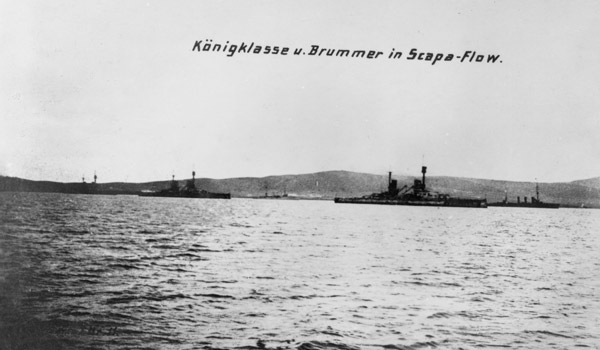History of SMS Brummer
SMS Brummer was a mine-laying vessel built by AG Vulcan shipyard in Stettin in 1915. At the outbreak of World War I there were only three minelayers in the German Navy and so SMS Brummer and her sister ship SMS Bremse were built to reinforce this number.
As mine-layers SMS Brummer and SMS Bremse were more lightly armoured, and less heavily armed, than light cruisers. They could carry 400 mines, two to four times the number which the light cruisers could carry.
SMS Brummer and SMS Bremse resembled British cruisers of the Aurora class due to the curved shape of the bow and the collapsible main mast. The hull incorporated three decks, oil being stored in bunkers in the bottom of the ship and coal being stored in bunkers along the sides.
In October 1917 the two ships intercepted a British convoy en route from Bergen, Norway to Lerwick, Shetland. They had been selected for this task due to their high speed, large radius of action and resemblance to British cruisers. In preparation for the raid, their crews painted the ships dark grey to further camouflage them as British vessels.
The two vessels sank the Admiralty M class destroyer HMS Mary Rose and the R class destroyer HMS Strongbow along with nine neutral Scandinavian vessels in the convoy.
In the words of the English poet, Sir Henry John Newbolt:
"Throughout the attack the Germans displayed a severity which is hard to distinguish from downright cruelty. They gave the neutral masters and crews no chance to lower their boats and get away, but poured their broadsides into them without warning, as though they had been armed enemies… In the case of the destroyers the enemies conduct was even worse; to their everlasting discredit fire was opened and maintained upon the Strongbow’s survivors."
The Germans said gunfire falling short meant victims in the water and the lifeboats were hit unintentionally. The attack killed 250 men. Four officers and 41 men were saved from HMS Strongbow. Only two officers and eight men survived the attack on HMS Mary Rose. Two trawlers in the convoy were undamaged and one of them rescued most of the survivors.
The successful action meant plans were considered to increase boiler space on SMS Brummer and SMS Bremse so they could become commerce raiders. However, the plans were never followed through.
SMS Brummer arrived in Scapa Flow for internment in November 1918.
- Nationality: German
- Launched: 11 December 1915
- Commissioned: 2 April 1916
- Builder: AG Vulcan, Stettin
- Construction No: 422
- Type: Light Steam Ship (direct translation from plans)
- Subtype/class: Fast mine-layer, Brummer Class
- Displacement (Standard): 4,385 tonnes
- Displacement (Full Load): 5,856 tonnes
- Length Overall: 140m *
- Beam: 13m
- Draught: 5.88-6 m
- Complement: 309
- Material: Steel
- Cause Lost: Scuttled
- Date lost: 21 June 1919. 1305 hrs
- Casualties: 0
- Propulsion: Two coal and four oil marine-type boilers, two steam turbines. Two propellers
- Power: 42,797 shp**
- Speed: 28 Knots
- Armour: Belt 40mm max, deck 15mm, control tower 100mm sides & 20mm roof
- Armament: 4 x 15cm guns, 2 x 8.8 anti-aircraft guns, 2 x 50cm deck-mounted torpedo launchers, 400 mines
* Measurements taken from ship's plans
**shp - shaft horsepower












